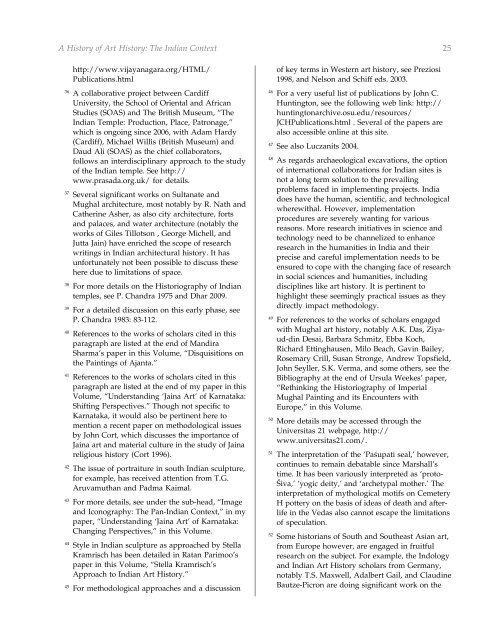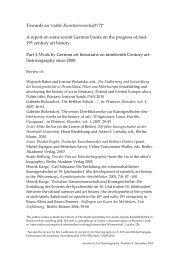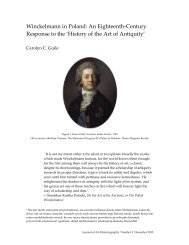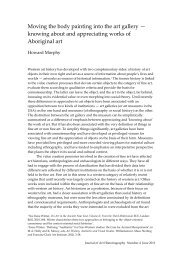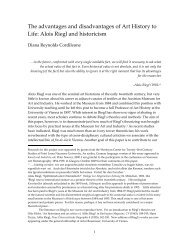Indian Art history.cdr - Journal of Art Historiography
Indian Art history.cdr - Journal of Art Historiography
Indian Art history.cdr - Journal of Art Historiography
Create successful ePaper yourself
Turn your PDF publications into a flip-book with our unique Google optimized e-Paper software.
A History <strong>of</strong> <strong>Art</strong> History: The <strong>Indian</strong> Context 25<br />
http://www.vijayanagara.org/HTML/<br />
Publications.html<br />
36 A collaborative project between Cardiff<br />
University, the School <strong>of</strong> Oriental and African<br />
Studies (SOAS) and The British Museum, “The<br />
<strong>Indian</strong> Temple: Production, Place, Patronage,”<br />
which is ongoing since 2006, with Adam Hardy<br />
(Cardiff), Michael Willis (British Museum) and<br />
Daud Ali (SOAS) as the chief collaborators,<br />
follows an interdisciplinary approach to the study<br />
<strong>of</strong> the <strong>Indian</strong> temple. See http://<br />
www.prasada.org.uk/ for details.<br />
37 Several significant works on Sultanate and<br />
Mughal architecture, most notably by R. Nath and<br />
Catherine Asher, as also city architecture, forts<br />
and palaces, and water architecture (notably the<br />
works <strong>of</strong> Giles Tillotson , George Michell, and<br />
Jutta Jain) have enriched the scope <strong>of</strong> research<br />
writings in <strong>Indian</strong> architectural <strong>history</strong>. It has<br />
unfortunately not been possible to discuss these<br />
here due to limitations <strong>of</strong> space.<br />
38 For more details on the <strong>Historiography</strong> <strong>of</strong> <strong>Indian</strong><br />
temples, see P. Chandra 1975 and Dhar 2009.<br />
39 For a detailed discussion on this early phase, see<br />
P. Chandra 1983: 83-112.<br />
40 References to the works <strong>of</strong> scholars cited in this<br />
paragraph are listed at the end <strong>of</strong> Mandira<br />
Sharma’s paper in this Volume, “Disquisitions on<br />
the Paintings <strong>of</strong> Ajanta.”<br />
41 References to the works <strong>of</strong> scholars cited in this<br />
paragraph are listed at the end <strong>of</strong> my paper in this<br />
Volume, “Understanding ‘Jaina <strong>Art</strong>’ <strong>of</strong> Karnataka:<br />
Shifting Perspectives.” Though not specific to<br />
Karnataka, it would also be pertinent here to<br />
mention a recent paper on methodological issues<br />
by John Cort, which discusses the importance <strong>of</strong><br />
Jaina art and material culture in the study <strong>of</strong> Jaina<br />
religious <strong>history</strong> (Cort 1996).<br />
42 The issue <strong>of</strong> portraiture in south <strong>Indian</strong> sculpture,<br />
for example, has received attention from T.G.<br />
Aruvamuthan and Padma Kaimal.<br />
43 For more details, see under the sub-head, “Image<br />
and Iconography: The Pan-<strong>Indian</strong> Context,” in my<br />
paper, “Understanding ‘Jaina <strong>Art</strong>’ <strong>of</strong> Karnataka:<br />
Changing Perspectives,” in this Volume.<br />
44 Style in <strong>Indian</strong> sculpture as approached by Stella<br />
Kramrisch has been detailed in Ratan Parimoo’s<br />
paper in this Volume, “Stella Kramrisch’s<br />
Approach to <strong>Indian</strong> <strong>Art</strong> History.”<br />
45 For methodological approaches and a discussion<br />
<strong>of</strong> key terms in Western art <strong>history</strong>, see Preziosi<br />
1998, and Nelson and Schiff eds. 2003.<br />
46 For a very useful list <strong>of</strong> publications by John C.<br />
Huntington, see the following web link: http://<br />
huntingtonarchive.osu.edu/resources/<br />
JCHPublications.html . Several <strong>of</strong> the papers are<br />
also accessible online at this site.<br />
47 See also Luczanits 2004.<br />
48 As regards archaeological excavations, the option<br />
<strong>of</strong> international collaborations for <strong>Indian</strong> sites is<br />
not a long term solution to the prevailing<br />
problems faced in implementing projects. India<br />
does have the human, scientific, and technological<br />
wherewithal. However, implementation<br />
procedures are severely wanting for various<br />
reasons. More research initiatives in science and<br />
technology need to be channelized to enhance<br />
research in the humanities in India and their<br />
precise and careful implementation needs to be<br />
ensured to cope with the changing face <strong>of</strong> research<br />
in social sciences and humanities, including<br />
disciplines like art <strong>history</strong>. It is pertinent to<br />
highlight these seemingly practical issues as they<br />
directly impact methodology.<br />
49 For references to the works <strong>of</strong> scholars engaged<br />
with Mughal art <strong>history</strong>, notably A.K. Das, Ziyaud-din<br />
Desai, Barbara Schmitz, Ebba Koch,<br />
Richard Ettinghausen, Milo Beach, Gavin Bailey,<br />
Rosemary Crill, Susan Stronge, Andrew Topsfield,<br />
John Seyller, S.K. Verma, and some others, see the<br />
Bibliography at the end <strong>of</strong> Ursula Weekes’ paper,<br />
“Rethinking the <strong>Historiography</strong> <strong>of</strong> Imperial<br />
Mughal Painting and its Encounters with<br />
Europe,” in this Volume.<br />
50 More details may be accessed through the<br />
Universitas 21 webpage, http://<br />
www.universitas21.com/.<br />
51 The interpretation <strong>of</strong> the ‘Paçupati seal,’ however,<br />
continues to remain debatable since Marshall’s<br />
time. It has been variously interpreted as ‘proto-<br />
Çiva,’ ‘yogic deity,’ and ‘archetypal mother.’ The<br />
interpretation <strong>of</strong> mythological motifs on Cemetery<br />
H pottery on the basis <strong>of</strong> ideas <strong>of</strong> death and afterlife<br />
in the Vedas also cannot escape the limitations<br />
<strong>of</strong> speculation.<br />
52 Some historians <strong>of</strong> South and Southeast Asian art,<br />
from Europe however, are engaged in fruitful<br />
research on the subject. For example, the Indology<br />
and <strong>Indian</strong> <strong>Art</strong> History scholars from Germany,<br />
notably T.S. Maxwell, Adalbert Gail, and Claudine<br />
Bautze-Picron are doing significant work on the


